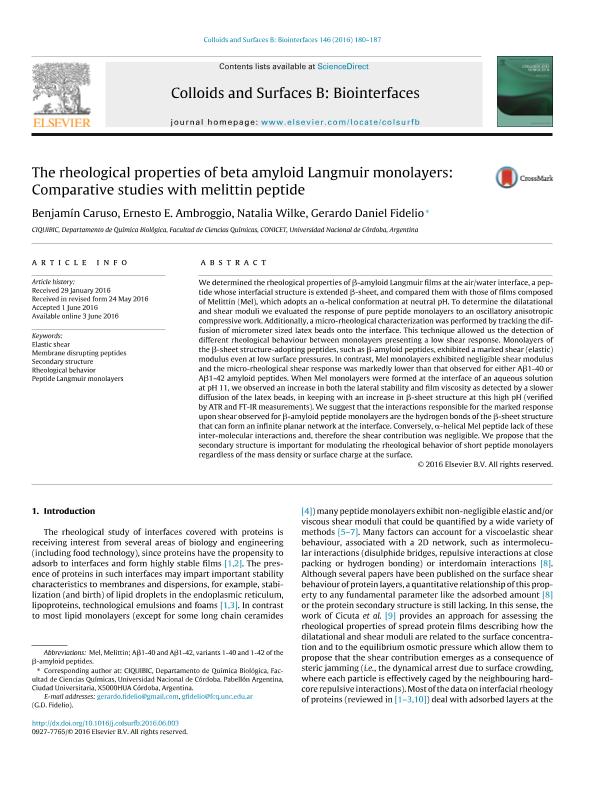Mostrar el registro sencillo del ítem
dc.contributor.author
Caruso, Benjamin

dc.contributor.author
Ambroggio, Ernesto Esteban

dc.contributor.author
Wilke, Natalia

dc.contributor.author
Fidelio, Gerardo Daniel

dc.date.available
2018-03-23T18:43:43Z
dc.date.issued
2016-10
dc.identifier.citation
Caruso, Benjamin; Ambroggio, Ernesto Esteban; Wilke, Natalia; Fidelio, Gerardo Daniel; The rheological properties of beta amyloid Langmuir monolayers: Comparative studies with melittin peptide; Elsevier Science; Colloids and Surfaces B: Biointerfaces; 146; 10-2016; 180-187
dc.identifier.issn
0927-7765
dc.identifier.uri
http://hdl.handle.net/11336/39827
dc.description.abstract
We determined the rheological properties of β-amyloid Langmuir films at the air/water interface, a peptide whose interfacial structure is extended β-sheet, and compared them with those of films composed of Melittin (Mel), which adopts an α-helical conformation at neutral pH. To determine the dilatational and shear moduli we evaluated the response of pure peptide monolayers to an oscillatory anisotropic compressive work. Additionally, a micro-rheological characterization was performed by tracking the diffusion of micrometer sized latex beads onto the interface. This technique allowed us the detection of different rheological behaviour between monolayers presenting a low shear response. Monolayers of the β-sheet structure-adopting peptides, such as β-amyloid peptides, exhibited a marked shear (elastic) modulus even at low surface pressures. In contrast, Mel monolayers exhibited negligible shear modulus and the micro-rheological shear response was markedly lower than that observed for either Aβ1-40 or Aβ1-42 amyloid peptides. When Mel monolayers were formed at the interface of an aqueous solution at pH 11, we observed an increase in both the lateral stability and film viscosity as detected by a slower diffusion of the latex beads, in keeping with an increase in β-sheet structure at this high pH (verified by ATR and FT-IR measurements). We suggest that the interactions responsible for the marked response upon shear observed for β-amyloid peptide monolayers are the hydrogen bonds of the β-sheet structure that can form an infinite planar network at the interface. Conversely, α-helical Mel peptide lack of these inter-molecular interactions and, therefore the shear contribution was negligible. We propose that the secondary structure is important for modulating the rheological behavior of short peptide monolayers regardless of the mass density or surface charge at the surface.
dc.format
application/pdf
dc.language.iso
eng
dc.publisher
Elsevier Science

dc.rights
info:eu-repo/semantics/openAccess
dc.rights.uri
https://creativecommons.org/licenses/by-nc-sa/2.5/ar/
dc.subject
Elastic Shear
dc.subject
Membrane Disrupting Peptides
dc.subject
Peptide Langmuir Monolayers
dc.subject
Rheological Behavior
dc.subject
Secondary Structure
dc.subject.classification
Otras Ciencias Biológicas

dc.subject.classification
Ciencias Biológicas

dc.subject.classification
CIENCIAS NATURALES Y EXACTAS

dc.title
The rheological properties of beta amyloid Langmuir monolayers: Comparative studies with melittin peptide
dc.type
info:eu-repo/semantics/article
dc.type
info:ar-repo/semantics/artículo
dc.type
info:eu-repo/semantics/publishedVersion
dc.date.updated
2018-03-21T16:29:03Z
dc.journal.volume
146
dc.journal.pagination
180-187
dc.journal.pais
Países Bajos

dc.journal.ciudad
Amsterdam
dc.description.fil
Fil: Caruso, Benjamin. Consejo Nacional de Investigaciones Científicas y Técnicas. Centro Científico Tecnológico Conicet - Córdoba. Centro de Investigaciones en Química Biológica de Córdoba. Universidad Nacional de Córdoba. Facultad de Ciencias Químicas. Centro de Investigaciones en Química Biológica de Córdoba; Argentina
dc.description.fil
Fil: Ambroggio, Ernesto Esteban. Consejo Nacional de Investigaciones Científicas y Técnicas. Centro Científico Tecnológico Conicet - Córdoba. Centro de Investigaciones en Química Biológica de Córdoba. Universidad Nacional de Córdoba. Facultad de Ciencias Químicas. Centro de Investigaciones en Química Biológica de Córdoba; Argentina
dc.description.fil
Fil: Wilke, Natalia. Consejo Nacional de Investigaciones Científicas y Técnicas. Centro Científico Tecnológico Conicet - Córdoba. Centro de Investigaciones en Química Biológica de Córdoba. Universidad Nacional de Córdoba. Facultad de Ciencias Químicas. Centro de Investigaciones en Química Biológica de Córdoba; Argentina
dc.description.fil
Fil: Fidelio, Gerardo Daniel. Consejo Nacional de Investigaciones Científicas y Técnicas. Centro Científico Tecnológico Conicet - Córdoba. Centro de Investigaciones en Química Biológica de Córdoba. Universidad Nacional de Córdoba. Facultad de Ciencias Químicas. Centro de Investigaciones en Química Biológica de Córdoba; Argentina
dc.journal.title
Colloids and Surfaces B: Biointerfaces

dc.relation.alternativeid
info:eu-repo/semantics/altIdentifier/doi/http://dx.doi.org/10.1016/j.colsurfb.2016.06.003
dc.relation.alternativeid
info:eu-repo/semantics/altIdentifier/url/https://www.sciencedirect.com/science/article/pii/S0927776516304337
Archivos asociados
